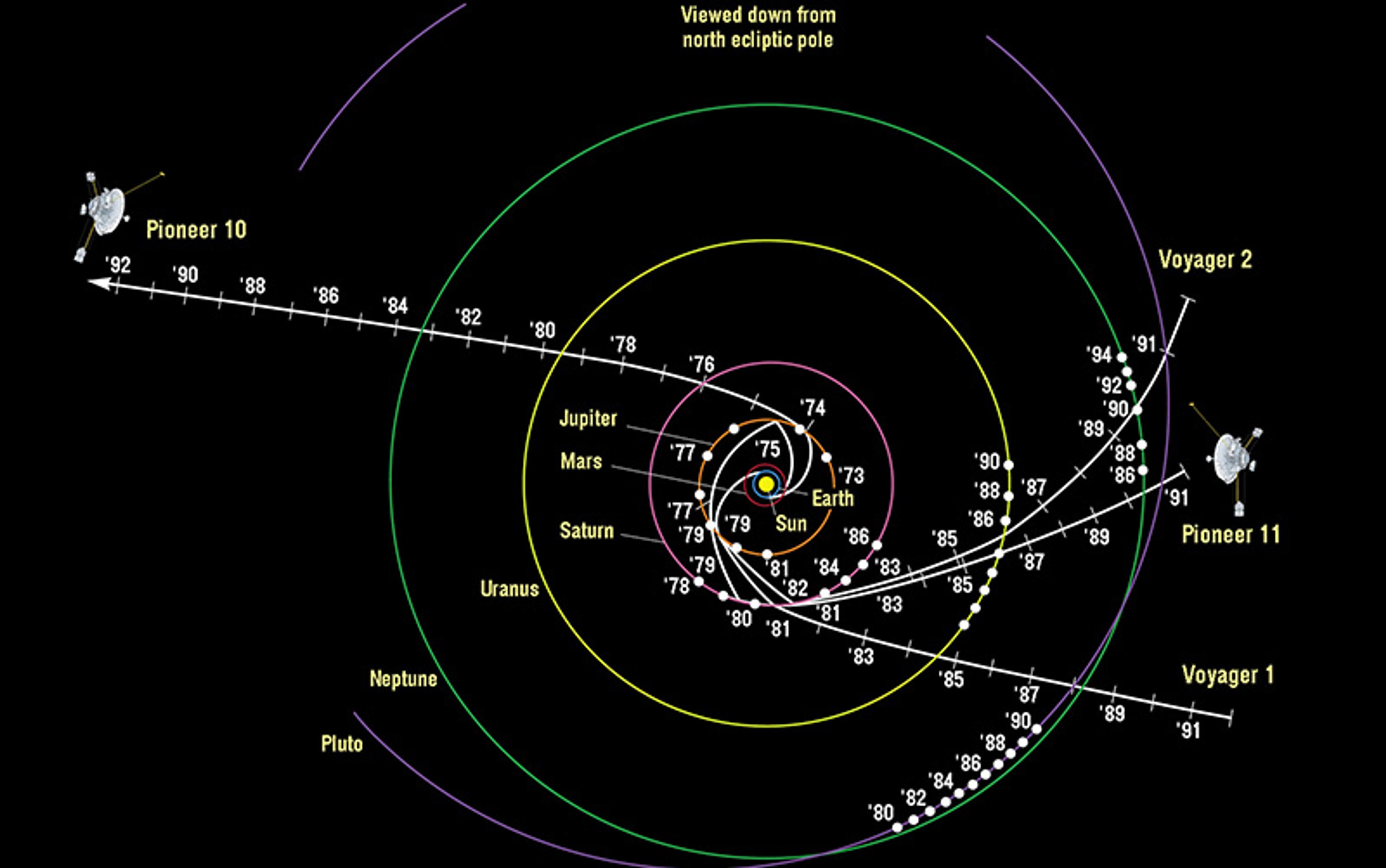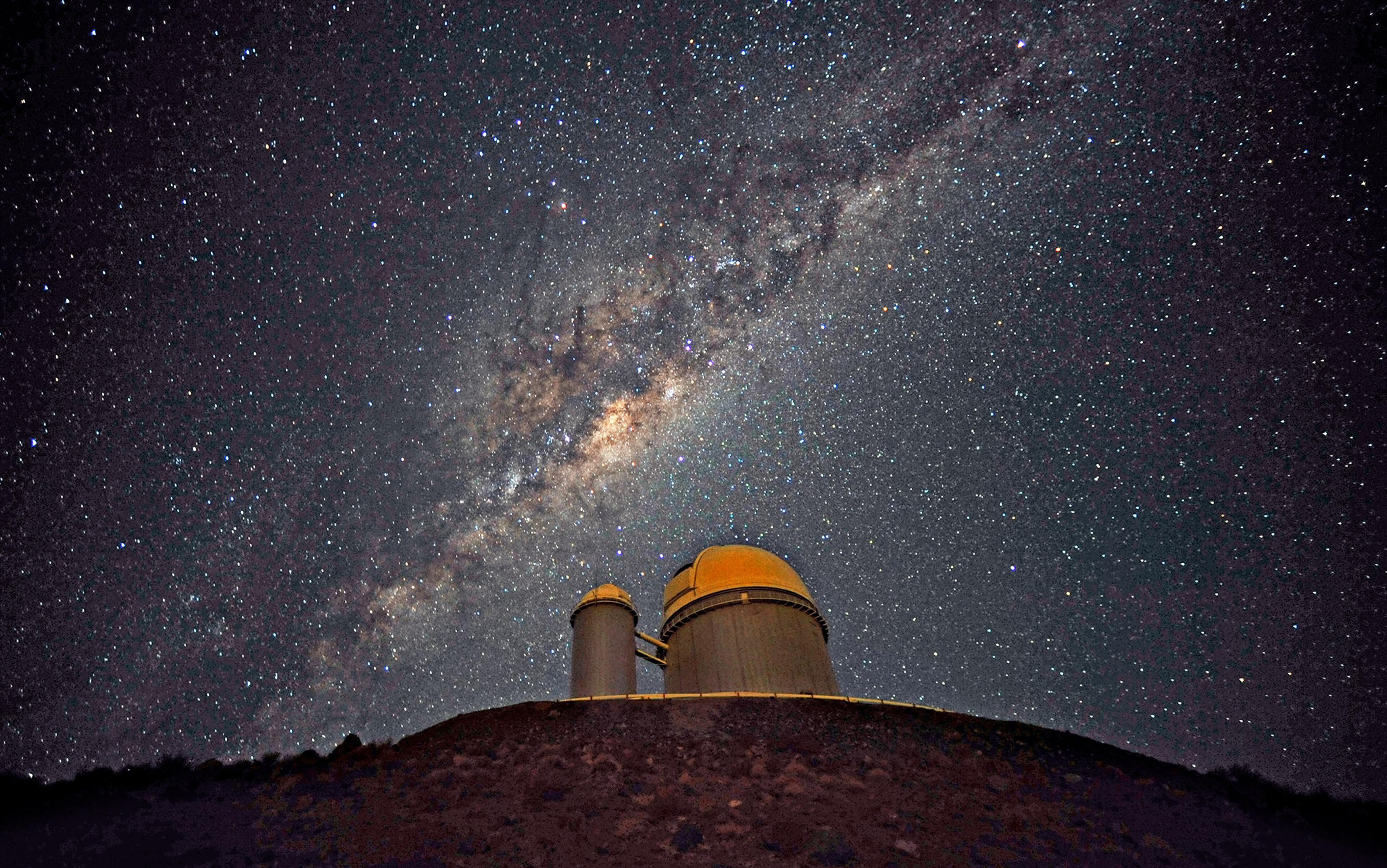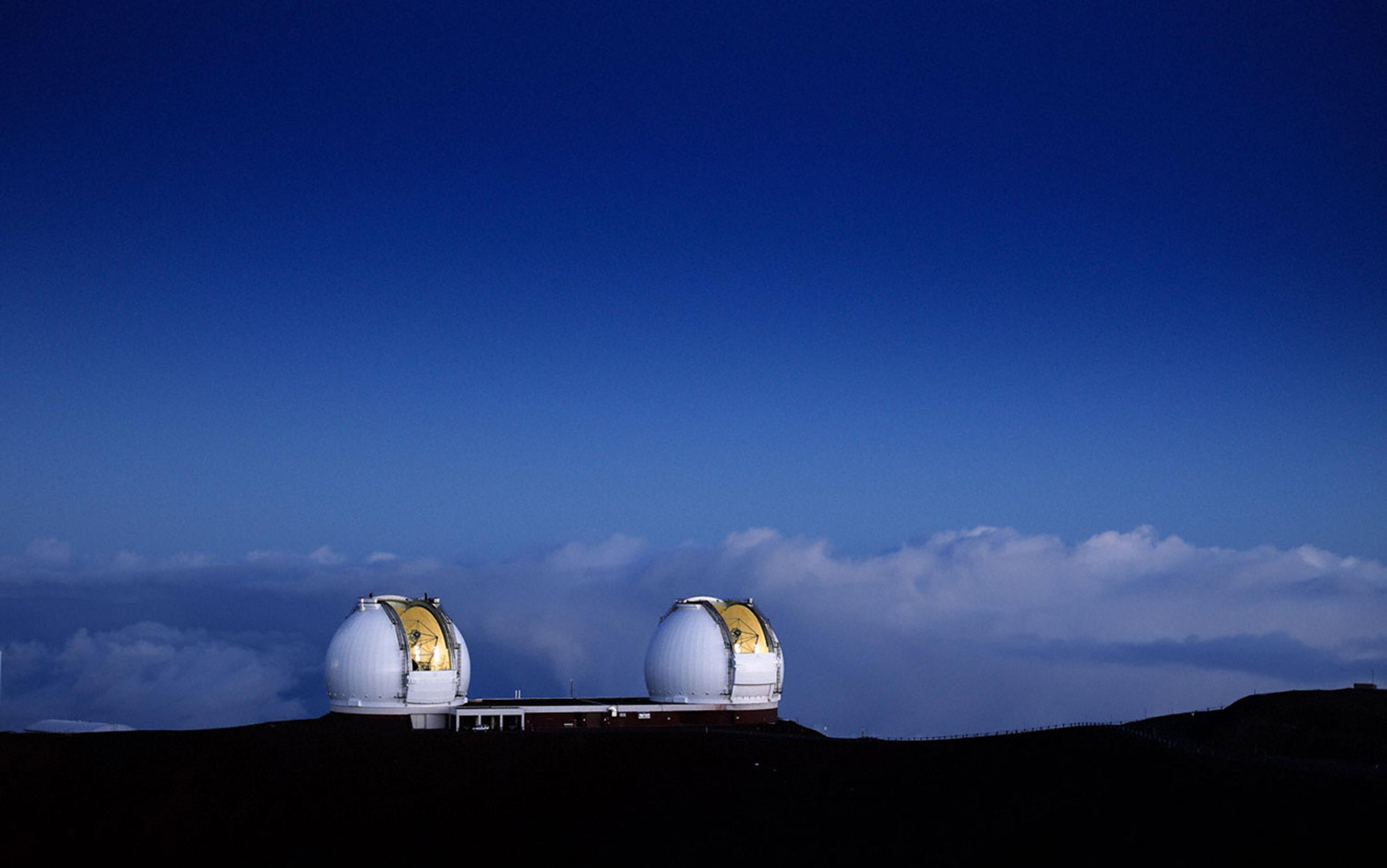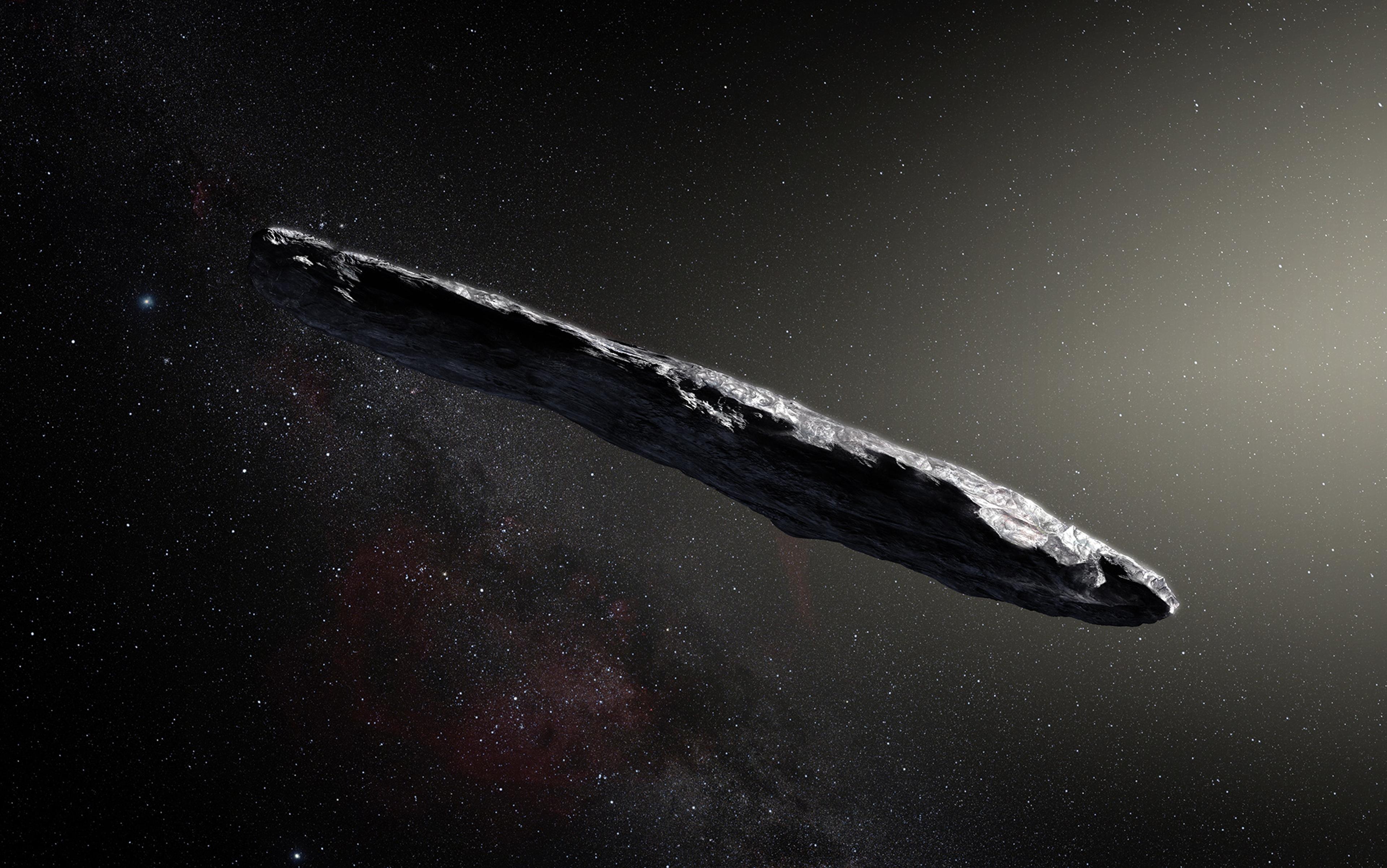Could extraterrestrial technology be lurking in our backyard – on the Moon, Mars or in the asteroid belt? We think it’s worth a look.
The idea that a planet like Mars might host cities and technology gained traction in scientific circles when Percival Lowell popularised his theory of ‘canals’ on Mars between 1894 and 1908. He claimed that these were artificial irrigation channels built by Martians to transport water from the poles to equatorial cities. Not all astronomers agreed with Lowell, but the possibility of an inhabited Mars couldn’t be immediately dismissed. The excitement generated by his hypothesis inspired works of science fiction like H G Wells’s War of the Worlds (1898), in which Martian invaders come to colonise Earth and exploit its resources. It also fuelled a growing public belief that we might not be too far from another population of advanced extraterrestrial beings.

A poster for the movie Invasion of the Saucer-Men (1957). Courtesy IMDB
What would it mean to find alien technology close to Earth? The implications would be shocking and transformative. Such a discovery would instantly upend humanity’s sense of itself in the hierarchy of the cosmos, suggesting that we are not alone, but that visitors have, in fact, been here before. The difference between an extraterrestrial civilisation light years away and one that has touched down or hovered so close to home could be the difference between unproven theory and documented reality. In a Universe where distances render most forms of contact nearly impossible, proximity changes everything.
Lowell’s hypothesis about canals on Mars did not last, of course. By the 1930s, improved instruments revealed that the ‘canals’ were optical illusions. And by the 1960s, scientific evidence had shut the door on the idea of alien civilisations within the solar system. Venus was too hot. Mars was barren. Science fiction turned to the stars – and, with the discovery of exoplanets (Earth-like worlds that could be habitable), so did science.

Pioneer and Voyager trajectories through the early 1990s. Courtesy NASA
Yet we can’t rule out the possibility that aliens have paid a visit, or that alien technology is already here. After all, our own space-exploration activities have included missions on trajectories beyond the boundaries of the solar system. The Voyager 1 and Voyager 2 spacecraft, launched by NASA in 1977, have already exited the solar system, while other spacecraft such as Pioneer 10, Pioneer 11 and New Horizons are all on course to reach interstellar space. Studies are currently underway by the Breakthrough Starshot project to develop a tiny ‘nanocraft’ that would be propelled with a laser toward the nearby Alpha Centauri star system at a fraction of the speed of light. These examples illustrate the possibility that human technology is at least conceptually capable of sending spacecraft to nearby planetary systems. And if this is something within our reach, then isn’t it possible that an extraterrestrial civilisation (if it exists) would also be capable of such a technological feat?
If the galaxy can give rise to a planet like Earth to develop life and technology, then we cannot rule out the possibility that other such planets exist. And if they do exist, and are actively exploring space like we are, isn’t it possible that their exploratory spacecraft could be lurking nearby? The possibility is worth keeping in mind as exploration of the solar system continues. But unfortunately, most scientific enquiry has tended to ignore the possibility of looking for extraterrestrial technology in nearby space, preferring instead to look far away.
The flood of exoplanet discoveries in the past two decades – almost 6,000 – has generated immense scientific interest in finding biology or technology on these distant worlds. The interest in searching for extraterrestrial life has extended beyond scientific circles and into the broader culture. The ongoing science is helping us become prepared, or more aware, of a potential future discovery of life on a distant world.
Academia is continuing to invest resources in biosignature science, a crucial field of research that seeks to identify signs of life in the Universe. Biosignatures, also known as biomarkers, are chemical or biological signals that indicate the presence of living organisms. Ongoing support for biosignature science is a testament to the growing importance of this field in the search for life beyond Earth.
Federal agencies like NASA have begun various research initiatives and mission concepts to look for biosignatures. One of the most notable examples is the Habitable Worlds Observatory, a flagship mission concept designed specifically to search for biosignatures in the atmospheres of exoplanets, with an anticipated launch in the 2040s. Meanwhile, researchers are now actively searching for biosignatures such as oxygen and/or methane that could be produced by living organisms on distant worlds. Over Earth’s 4.5 billion-year evolutionary history, atmospheric oxygen has been present for only about 2.5 billion years. Prior to 2.7 billion years ago, the planet was both habitable and inhabited, with carbon dioxide and methane serving as the primary gases that created life-sustaining conditions. The discovery of exoplanets, particularly those located in the habitable zones of their stars, has created a new frontier in the search for life beyond Earth.
Abundant amounts of pollutants on an exoplanet would suggest the possibility of a technological civilisation
Yet the science of biosignatures is not limited to exoplanet research. Decades of research into biosignatures on Mars and other celestial bodies in our solar system has been ongoing. For example, Perseverance, the NASA Mars rover that landed on Mars in 2021, is equipped with instruments designed to search for signs of ancient microbial life on the Martian surface. Recent research searching for signs of life on the moons of Saturn (Enceladus, Titan) and Jupiter (Europa and Ganymede), two of the gas giants in our solar system, has shown that these giant moons contain vast amounts of water in sub-surface oceans. Water is a key ingredient for all life as we know it, and the discovery of oceans may help us in further investigating the potential for life on these moons. All of these efforts in searching for biosignatures in exoplanets or the solar system are intended to answer one of humanity’s most profound questions: are we alone in the Universe?
The search for biosignatures in exoplanets has also started to expand beyond thinking about signs of biology alone to include the possibility that life on exoplanets has evolved to the point of having technology, like we do. The idea of searching for resulting ‘technosignatures’ as remotely detectable evidence of extraterrestrial technology follows the same logic as exoplanet biosignature science, by considering the possible consequences of technology on a planet that might be detectable with a telescope like the Habitable Worlds Observatory.
From pollution to city lights, our own planet serves as a roadmap. There are studies currently underway proposing possible technosignatures that could arise on planets around other stars. Unsurprisingly, they are tied to what current Earth technology can produce, much like the search for biosignatures, which relies on Earth’s current and past history as a reference. One possibility is to remotely detect tell-tale chemical compounds in exoplanetary atmospheres that would indicate the presence of technology on the planet. An example from Earth is pollution from fossil fuels, which includes the accumulation of nitrogen dioxide as a result of widespread combustion. Another example is the release of industrial compounds such as chlorofluorocarbons (CFCs) and fluorine-containing minerals, which can have long atmospheric lifetimes and can also be potent greenhouse gases. Abundant amounts of any of these pollutants on an exoplanet would suggest the possibility of a technological civilisation, unless we could think of other ways of generating such compounds without invoking technology. Another possibility is searching for nighttime city lights that could be observable with space telescopes as distinct from other sources of light. Searches such as these are based on the technology of present-day and near-future Earth, simply because it is often hard to imagine an advanced technology that is centuries, or perhaps millennia, ahead of us. To the degree that we can imagine far future tech, it behoves us to ask: if advanced technology exists on distant planets, why couldn’t at least a probe be sent here?
The idea that extraterrestrial technology might exist on a planet beyond our solar system is already woven into our cultural imagination. We envision distant worlds with industries, civilisations that have undergone scientific revolutions like our own, governed by the same physical laws and built from the same elements found in our periodic table. These hypothetical civilisations might not be at our technological level – but they may possess some form of technology nonetheless. And we, as a civilisation, are now in a position to detect it. When we entertain such possibilities, we’re not just speculating – we’re leaning on a foundation of scientific theory and observation that continues to guide the search for exoplanetary technology, if it exists.
The scientific literature has less to say about the possibility of finding technosignatures in our solar system. The idea that extraterrestrial technology could be residing in the solar system was first suggested by Ronald Bracewell in the journal Nature, in his paper ‘Communications from Superior Galactic Communities’ (1960).
Bracewell proposed that the search for extraterrestrial technology was worth serious consideration, especially since humanity itself was developing the capability for interstellar travel. He reasoned that advanced civilisations – comparable to or more evolved than ours – might not focus on specific star systems, but might instead explore broadly, dispatching probes to nearby stars. Rather than simply gathering data, these probes would prioritise the transmission of information. From an energy and efficiency standpoint, it would make more sense to send long-lived, autonomous devices capable not only of detecting intelligent life but also of initiating communication. Such probes, he suggested, might need to be self-sufficient and possibly equipped with artificial intelligence.
Since the time of Bracewell’s paper, a handful of spacecraft – including the Pioneer and New Horizons missions – are now on a trajectory to exit the outermost parts of the solar system, where they will continue to drift into interstellar space. Both Voyager 1 and 2 have already exited the solar system. None of these missions are directed toward any particular destination, but the ability to send interstellar probes toward exoplanetary systems of interest is within our technological grasp. And mission concepts like Breakthrough Starshot are even studying ways to enable efficient interstellar flight by using a large laser to accelerate nanocraft toward the Proxima Centauri system, the nearest stellar system with a terrestrial mass planet in the habitable zone. As Bracewell reasoned, the technological foundation for interstellar spaceflight exists on Earth today, so it is at least technologically feasible that extraterrestrial technology could have been sent here.
Its unusual shape sparked the provocative idea that it might be an artificial probe sent by aliens
But only a handful of exploratory searches have ever been conducted to test Bracewell’s bold hypothesis – that extraterrestrial civilisations might send autonomous probes to observe intelligent life elsewhere. One promising search strategy focuses on Lagrange points – gravitationally balanced zones that exist in the orbital relationship between two large celestial bodies, like Earth and the Sun. These zones are semi-stable, meaning an object placed there can remain in position with minimal fuel or thrust. In fact, modern spacecraft often take advantage of these cosmic parking spots: NASA’s James Webb Space Telescope, for instance, is parked at what’s called the Earth-Sun L2 Lagrange point.
Back in the early 1980s, the scientists Robert Freitas Jr and Francisco Valdes searched some of these locations for signs of alien technology, including the regions around Earth and the Moon, and between Earth and the Sun. They used both visible light (optical) telescopes and instruments sensitive to radio waves. Their conclusion? If there were any non-functioning probes or other artificial objects about 10 metres across or larger, their search would likely have spotted them – at least during the time periods they observed.

An artist’s impression of the interstellar object ʻOumuamua, the first confirmed object from another star to visit our solar system. Courtesy NASA

ʻOumuamua, circled and surrounded by the trails of faint stars that smeared as the telescopes tracked the moving comet. Courtesy ESO/K Meech et al
More recently, scientists have turned their attention to interstellar visitors – objects that enter our solar system from deep space. One of the most intriguing examples is ʻOumuamua, a cigar-shaped body detected in 2017 as it raced past the Sun on a trajectory that made it clear it came from beyond our solar system. Its unusual shape, acceleration and lack of a visible comet tail sparked widespread speculation – including the provocative idea that it might be an artificial probe sent by an alien civilisation. In response to that possibility, astronomers quickly trained radio telescopes on ʻOumuamua, scanning it for signals that might suggest technological origin. No radio signals were detected, and subsequent analyses leaned toward a natural explanation. Today, most scientists consider ʻOumuamua to be a previously unknown type of interstellar comet – the first such object ever observed.
Another recent example is a study led by Beatriz Villarroel and her team that examined old photographic plates from April 1950 taken by the Palomar telescope sky survey. In these plates, they discovered nine transient sources – brief, starlike appearances – that were absent from earlier and later plates. If sources of contamination can be excluded, the study explores the possibility that these sources could be reflections of sunlight on objects in orbit around Earth. A curious aspect of this study is that these photographic plates predate the launch of the first satellite by humans (Sputnik, in 1957); if these observations actually are objects in orbit, then they could not be objects launched by humans. While the study provides no definitive conclusions, it highlights the potential of archival astronomical data in the search for non-terrestrial artefacts.
Other theoretical studies have suggested searching for ‘non-terrestrial artefacts’, such as defunct or active probes, on the surface of planetary bodies like the Moon or Mars. Performing such a search is becoming increasingly feasible by using tools like machine learning to analyse large datasets from spacecraft for possible anomalies. One such approach is attempting to analyse high-resolution images of the Moon to look for possible technosignatures – the existence of the Apollo landing sites and other crashed spacecraft even provide experimental controls on such a search, as known technology on the Moon. A few other possibilities exist for places to look, but such efforts are scant and incomplete when compared with the theoretical and observational momentum for biosignature detections within our solar system.
The search for technosignatures in the solar system remains in its infancy, compared with the search for biosignatures – here or abroad – and the search for technosignatures in exoplanets. Biosignature science has established itself as a mainstream discipline over several decades, which has resulted in a complete and rigorous set of theoretical possibilities that could lead to the detection of biosignatures in distant exoplanet environments or nearby planetary bodies in the solar system. Technosignature science that falls under the umbrella of remote biosignatures has begun to develop a similar robust theoretical basis for using space telescopes to look for signs of technology, in tandem with signs of biology.
Within our own solar system, we’ve followed a different path. Here, scientists have developed detailed, testable hypotheses for biosignatures grounded in decades of research. These include looking for microbial life in the subsurface oceans of icy moons like Europa and Enceladus, or seeking ancient organic material in Martian soil. The strategies are systematic and built upon well-defined models of how life might arise and survive in these environments.
When it comes to technosignatures within the solar system, however, the theoretical foundation is far less developed. There is no equivalent framework of rigorously formulated possibilities to guide a systematic search. While ideas exist – such as looking for artefacts in stable orbital regions or scanning the Moon for unnatural materials – these efforts remain fragmented, speculative and exploratory, lacking the methodological cohesion seen in biosignature research. Do these scattered clues mean anything? To answer the question, we’ll have to concede it has merit at all.
The idea of advanced societies ‘out there’ – on distant exoplanets – is just easier to accept than the notion that they have been here, close to home. The search for biosignatures and technosignatures on exoplanets is deeply rooted in science, because there actually is a body of science to draw upon.
Take the case of so-called technological ‘megastructures’, which captured the public imagination in 2015 when the astronomer Tabetha Boyajian reported unusual fluctuations in light from the star KIC 8462852 – now known as Tabby’s (Boyajian’s) Star. Some scientists and media outlets speculated that the dimming could be caused by massive orbiting structures, like solar panels or starshades, built by an advanced civilisation. Today, most astronomers believe the irregularities are caused by natural phenomena, like rocky debris. Still, the idea was taken seriously enough to be explored in scientific literature and widely discussed in the press. No one panicked over the possibility that Boyajian’s star might be the home of an advanced civilisation. Science was ready to address such a scenario, and the vast interstellar distance between us and the star helped keep the scenario comfortably hypothetical.
But the idea of discovering technosignatures within our own solar system, on Mars, the Moon or even on Earth, is far harder to accept. One reason is that science simply isn’t prepared for it. Theoretical discussions are limited, and serious search efforts remain rare. In mainstream scientific circles, the topic is still considered fringe – which only reinforces the lack of rigorous enquiry into solar system technosignatures.
The deeper issue, though, may be psychological and political. A close encounter with alien technology could spark geopolitical instability. Unlike some abstract suggestion of a distant exoplanet signal, a discovery near Earth would carry the weight of perceived threat. World governments might scramble to respond, not out of curiosity, but fear. To consider such a possibility would demand new strategies, new science and a level of intellectual risk we’ve so far resisted. And if the discovery does ever come, it could provoke fear, confusion or overreaction.
This vacuum, filled by fringe narratives, has made scientists wary of engaging with the topic
But we need to overcome this resistance to learn what’s here. And we cannot do that unless we conduct targeted searches and examine the data we already have. Nearly all planetary science missions today have the technology to help search for technosignatures in the solar system. The fleet of orbiters, rovers and probes already exploring the inner and outer planets can leverage many of their existing cameras and sensors to meaningfully seek technosignatures within the relevant regions of space.
The idea that technosignatures might exist within our solar system offers powerful motivation to analyse existing data and remain alert to unexpected anomalies. If such signatures are present, they could be hiding in unlikely places – and possibly even discovered by planetary scientists who aren’t looking for them. Staying open to the possibility, and reviewing already-collected data with that mindset, could go a long way toward identifying extraterrestrial technology, if it is there at all.
In the course of such an effort, even negative results matter. A thorough search of, say, the Moon that turns up no evidence of alien artefacts at a given resolution allows us to confidently rule out the presence of surface-level structures or large-scale technological remnants. And the more rigorously we search without finding anything, the more confident we can be in concluding that such technosignatures are unlikely to be there. The main cost of this kind of investigation is the extra effort required to perform the analysis – but the potential scientific payoff could be enormous.
The barriers to searching for technosignatures within our solar system are not technological – they’re cultural. While interest in life elsewhere in the Universe has surged, the idea of nearby technosignatures has lagged behind, often dismissed or overshadowed by speculation rooted in science fiction and pseudoscience. This vacuum, filled by fringe narratives, has made scientists wary of engaging with the topic for fear of damaging their reputations. The notion that a local technosignature could pose a security threat adds to the reluctance. Cultural stigma continues to discourage researchers from even low-risk efforts, such as examining existing planetary data for unexplained anomalies. When these pressures ripple through the scientific community, they can create an informal but powerful taboo – one that sidelines legitimate lines of investigation.
This isn’t how science should work. The search for technosignatures is grounded in a simple truth: technology has emerged at least once – here on Earth. Beyond that, the possibilities are wide open. We shouldn’t limit ourselves to searches of planets light years away when extraterrestrial technology might exist within our own solar system. To explore this seriously, we need to prioritise data collection and accessibility, enabling interdisciplinary teams – engineers, scientists and data analysts – to investigate potential signals, rule out false positives, and establish clear criteria for distinguishing genuine anomalies from noise. Scientists must be willing to take intellectual risks: to mine existing datasets or gather new ones, and to examine places in the solar system that might harbour such evidence. Rigorous enquiry into solar system technosignatures won’t just expand scientific understanding – it will help us prepare. And preparation, after all, is better than ignorance.
The views and opinions expressed here are the authors’ own and not those of their employers.
This Essay was made possible through the support of a grant to Aeon Media from the John Templeton Foundation. The opinions expressed in this publication are those of the author and do not necessarily reflect the views of the Foundation. Funders to Aeon Media are not involved in editorial decision-making.






